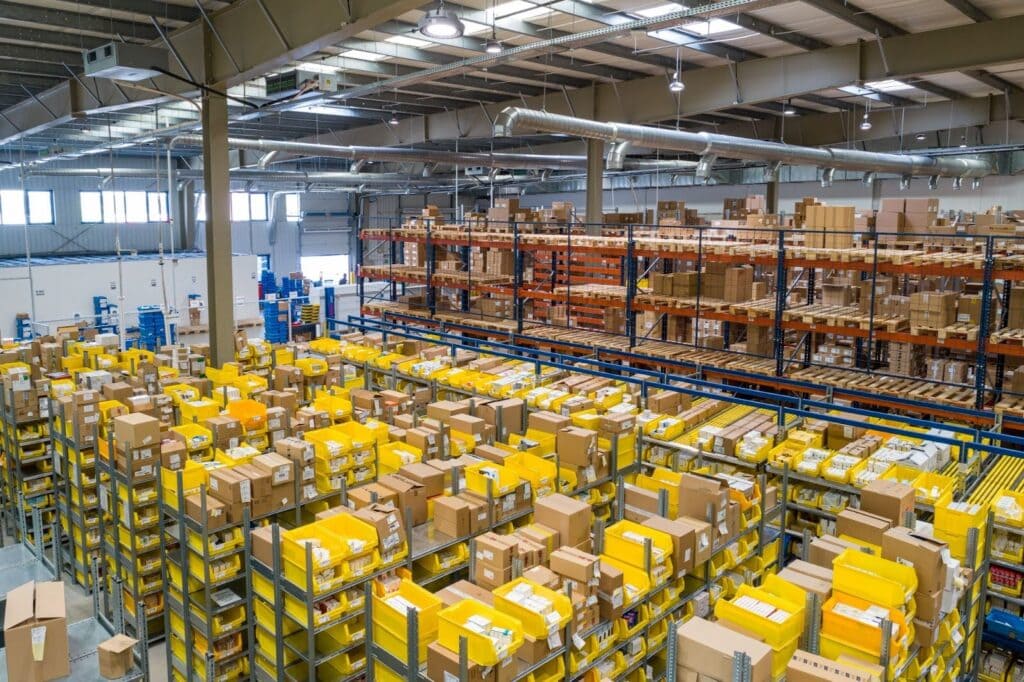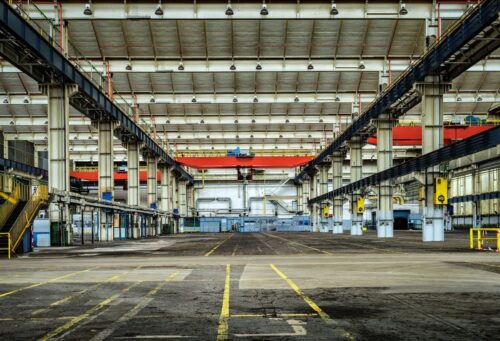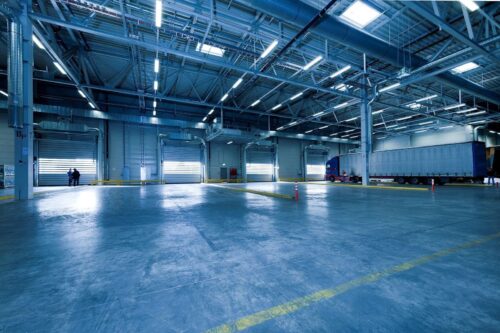Warehousing Process: Steps And Role In Fulfillment Efficacy

Warehousing is essential in today’s fast-paced supply chain, key to efficient order fulfillment and customer satisfaction. This article delves into the warehousing process, examining each step, from receiving goods to distribution, and how they collectively enhance supply chain efficiency. Discover these processes’ crucial roles in boosting your business’s fulfillment success.
Primary Warehouse Process Steps: How They Impact Efficiency In Supply Chain

Efficient warehouse processes are essential for effective logistics and supply chain management. They enable quick, accurate fulfillment of customer orders, ensuring better inventory control and space utilization. This leads to reduced costs in storage and transportation.
Regarding the primary warehouse process steps, here are each one of the crucial roles in impacting efficiency in the supply chain:
Receiving And Logging
Receiving and logging are vital for warehouse efficiency and accurate supply chain management. This process includes inspecting, counting, and recording goods on arrival, ensuring consistency with purchase orders, and maintaining inventory accuracy.
Effective management involves streamlined procedures, technology use like barcoding, and proper training for receiving teams. Challenges like delayed shipments and inaccurate orders can disrupt the process, but systematic approaches and technology utilization can enhance efficiency and minimize errors.
Put-Away Goods
The Put-Away Goods warehouse process efficiently moves received items to their optimal storage locations. This step is vitall for minimizing travel time within the warehouse, enhancing safety, maximizing space utilization, and simplifying the tracking and retrieval of goods.
Employing direct and indirect put-away strategies based on warehouse size and item variety is effective. Integrating Warehouse Management Systems (WMS) can optimize this process through real-time analytics and storage capacity monitoring, ultimately improving overall warehouse operations and efficiency.
Storing Goods
Efficient storage of goods in warehouses is vital for optimizing supply chain operations. It involves strategic organization and placement of items for easy access and inventory tracking, enhancing processes like receiving and picking.
Proper storage maximizes space utilization, improves labor productivity, and ensures real-time inventory visibility. Modern warehouses employ various storage types, like cold units and palletized racks, tailored to specific goods.
Picking Goods
The warehouse picking process is essential for fulfilling customer orders by selecting and retrieving the required goods. To improve this process, strategies like batch picking, which groups similar orders, and zone picking, where pickers work in designated areas, are effective.
Wave picking optimizes the process based on a schedule suitable for large warehouses with diverse SKUs, while discrete picking works well for smaller operations.
Packing
The packing process in warehouses is vital for the safe and efficient distribution of products. It involves placing picked items into appropriate packaging and securing them for transport. Efficient packing ensures product safety during transit, preventing delivery errors and losses.
Packing stations in warehouses are designed for this purpose, equipped with necessary materials, and integrated with warehouse management systems for streamlined operations. A well-executed packing process boosts productivity and ensures customer satisfaction by delivering orders accurately and intact.
Shipping
Shipping in warehouse operations is a complex process involving order processing, putaway and picking, packing, and labeling, which is key for timely and accurate delivery to customers.
Efficiency in shipping is enhanced through online portals for customer communication, optimized storage locations based on order frequency, and technology like RFID and wearable devices. Accurate weighing, dimensioning, documentation, and well-planned loading strategies are essential.
Secondary Warehouse Process Steps: How They Improve Efficiency In The Supply Chain

Implementing these steps can enhance efficiency and improve overall performance in the supply chain.
Dispatching
Dispatching is allocating and delivering goods or resources from a warehouse to their destinations. Establishing an efficient process for timely delivery, accurate order fulfillment, and effective inventory management is vital. This ensures customer satisfaction, cost reduction, and increased productivity, benefiting business operations.
Key practices include using real-time tracking and telematics systems for vehicle monitoring, implementing dynamic routing and scheduling software that adapts to real-time conditions, and prioritizing vehicle maintenance to minimize downtime.
Kitting (Bundling)
Kitting in supply chain management involves grouping related items into a single unit or kit for efficient sale and shipment. It enhances inventory management, streamlines order fulfillment processes and reduces costs and lead times.
Differing from bundling, which groups identical items, kitting combines various products under one SKU. This process is particularly beneficial in e-commerce, enabling efficient handling of diverse items like subscription boxes, technology components, or meal kits.
Casing (Logistics Of Fragile Goods)
Casing, in logistics, refers to packaging and protecting delicate items before transportation or storage. Establishing this process in a warehouse environment is imperative to ensure the safe handling and delivery of fragile goods. Proper casing minimizes the risk of damage during transit, reducing costs and maintaining customer satisfaction.
Key aspects of casing include proper packaging, labeling, and documentation. By identifying opportunities to optimize the casing process, warehouses can enhance the entire process and ensure the safe delivery of fragile goods to customers.
Inventory Monitoring With Software
Inventory monitoring with software is a secondary process step in warehouses that significantly improves efficiency in the supply chain.
By utilizing advanced software systems, warehouses can accurately track and manage their inventory in real-time, ensuring optimal stock levels and reducing the risk of stockouts or overstocking.
This software enables automatic data collection, analysis, and reporting, providing warehouse managers with valuable insights to make informed decisions and streamline operations.
Value-Added Customized Assembly
Value-added customized assembly in warehousing and supply chains involves tailoring products to specific customer needs, enhancing efficiency and customer satisfaction. It streamlines processes by integrating design simplification, advanced assembly techniques, and multifunctional systems.
This approach reduces cost lead times, and improves responsiveness, vital for competitive markets. Companies use in-house services like welding, machining, and testing to deliver cost-effective manufacturing solutions.
Managing Returns
Managing returns is a significant aspect of warehouse operations. It ensures efficient supply chain management and customer satisfaction. By establishing a well-defined process for handling returns, warehouses can streamline operations and minimize disruptions.
This process includes implementing efficient return authorization procedures, inspecting returned items for quality and condition, and determining appropriate disposition. Effective returns management improves inventory accuracy, reduces costs associated with returns, and enhances customer trust and loyalty.
Accessing Reports And Analyzing Data
Accessing reports and analyzing data is a significant step in optimizing efficiency in the supply chain. Reports provide insights into warehouse operations, such as inventory levels, order fulfillment rates, and storage utilization.
Data analysis helps identify patterns and trends, enabling better decision-making and increased warehouse efficiency. By making data-driven adjustments and optimizations, processes can be streamlined to meet customer demands effectively.
Initiating Damage Control
Managing damage control in a warehouse involves strategic planning, regular staff training, and practical measures. Conducting regular staff training and meetings to reinforce safe handling procedures, weatherproofing the warehouse to protect against environmental damage, and using appropriate tools and machinery are part of best practices.
Optimizing the warehouse layout, maintaining cleanliness, ensuring effective lighting, conducting regular maintenance and inspections, securing loading docks, and using stretch wraps and safety straps are crucial.
The Role Of Fulfillment Efficacy
The role of fulfillment efficacy in warehouse operations is critical for meeting customer expectations and increasing overall efficiency. As a warehouse manager, you are vital in optimizing the warehouse process to maximize fulfillment efficacy.
This includes managing inventory, implementing efficient picking and packing processes, utilizing 3PL warehouse solutions when necessary, and optimizing warehouse space and layout to minimize errors and improve productivity.
Warehouse Managers
Warehouse managers are vital in managing daily warehouse operations, including overseeing warehousing, distribution, and maintenance. They play a key role in space utilization, policy implementation, and maintaining health and safety standards.
Their responsibilities include inventory management, budgeting, liaising with stakeholders, team management, and performance reporting. They contribute significantly to strategic planning in supply chain management, aiming to enhance business development and customer satisfaction.
Warehouse Operations
Technological advancements increasingly shape modern warehouse operations. Key trends include the extensive use of robotics and automation for tasks like sorting and picking and the implementation of Warehouse Management Systems (WMS) for improved tracking and process control.
Inventory tracking technologies like RFID and OCR are enhancing accuracy and transparency. Additionally, wearables, Internet of Things (IoT) solutions, and immersive technologies like VR/AR boost efficiency, safety, and decision-making in warehouse environments.
Warehouse Process
Warehouse process refers to the activities and procedures involved in optimizing the efficiency of a warehouse ensuring timely delivery of goods to customers. This includes streamlining operations, implementing automated inventory management and order-picking systems, and balancing automation with human labor to maximize productivity.
Minimizing errors, reducing order processing time, and increasing overall efficiency are key goals of warehouse process optimization.
3PL Warehouse Solutions
3PL Warehouse Solutions optimize delivery, enhance fulfillment, and improve warehouse operations. They offer flexible storage, advanced inventory management, and efficient order fulfillment. With 3PL Warehouse Solutions, you streamline operations, improve accuracy, reduce processing time, and deliver a better customer experience.
Warehouse Space And Layout
Warehouse space and layout are vital for efficient fulfillment. They affect storage, organization, and access to goods. A good layout minimizes travel time and boosts storage capacity, resulting in quicker order fulfillment.
Conversely, more space or an efficient layout leads to congestion, delays, and reduced productivity. Planning and optimizing space and layout are crucial for smooth operations and meeting customer needs.
Automation
Warehouse automation significantly improves efficiency, safety, and customer satisfaction by streamlining operations and minimizing errors. It includes advanced technologies like AI, robotics, drones, and automated vehicles, enhancing labor management and reducing operational costs.
Automation allows for scalable operations and increased resilience to market changes, promoting sustainability practices and improving overall visibility and risk management in the warehouse—this integration of technology results in a more efficient, adaptable, and safer warehouse environment.
Software And Technology
Software and technology greatly enhance warehouse fulfillment. Warehouse management systems (WMS) optimize inventory control and logistics. Automation systems improve efficiency. Robotics and connectivity advancements enable real-time adjustments, coordination, and communication.
Implementation of software and technology improves logistics, productivity, and customer satisfaction. Careful consideration of pros and cons is important for successful implementation.
Warehousing, Supply Chain, And The Future Role Of 3PL
The warehousing industry has experienced a significant shift from traditional warehousing to third-party logistics (3PL) warehousing. Traditional warehousing focused mainly on storage and basic goods management, but as global business expanded, its limitations became evident.
3PL services, evolving since the 1970s and particularly expanding post-1980 due to the Motor Carrier Act, offer integrated warehousing and transportation services tailored to global market demands. Today’s 3PL services provide scalable, customized logistics solutions driven by technological and global supply chain complexities.
The pros and cons of 3PL services are the following.
Pros:
- Cost Savings: Economies of scale and lower costs through established carrier and supplier relationships.
- Increased Efficiency: Expertise in logistics and supply chain management.
- Flexibility: Customizable services to meet specific business needs.
- Focus on Core Competencies: Allows businesses to concentrate on their main operations.
- Scalability: Quick adjustment to changing demand patterns.
Cons:
- Coordination and Communication Challenges: Potential issues in smooth supply chain operation.
- Loss of Control: Relinquishing some control over logistics functions.
- Dependency: Risk associated with reliance on a 3PL provider.
This evolution signifies a move towards more integrated, technologically advanced logistics solutions, though it requires careful consideration of the potential challenges in coordination and control within the supply chain.
FAQs
Here are some commonly asked questions about the warehousing process.
What are the 6 processes of warehousing?
The six warehousing processes are receiving, storing, picking, packing, shipping, and returns. Receiving involves inspecting and documenting incoming goods. Storing is organizing and storing goods in the appropriate location.
Picking is retrieving goods for order fulfillment. Packing ensures proper packaging. Shipping coordinates transportation. Returns handle and process returned goods. Understanding these processes ensures efficient warehouse operation.
What are the 5 stages of warehousing?
The 5 warehousing stages are receiving, storage, picking, packing, and shipping. During receiving, goods are inspected and recorded. In storage, inventory is organized. Picking involves selecting items for orders. Packing prepares items for shipment. Shipping completes the process.
What are the steps in warehouse processing?
The steps in warehouse processing include receiving, organization, fulfillment, and distribution. During receiving, goods are inspected and documented. Organization involves storing and categorizing goods.
Fulfillment focuses on picking and packing orders. Distribution involves shipping orders to customers. These steps ensure smooth operations and timely order fulfillment in a warehouse.
Key Warehouse Processes Finalized
The warehousing process is a crucial aspect of supply chain management and plays a significant role in order fulfillment efficiency. With advanced technology and automation, warehouses can streamline operations and improve efficiency.
As the industry evolves, warehouses’ role and impact on fulfillment efficacy will become more important. Visit Inbound Logistics resources regarding the warehouse process and more.
